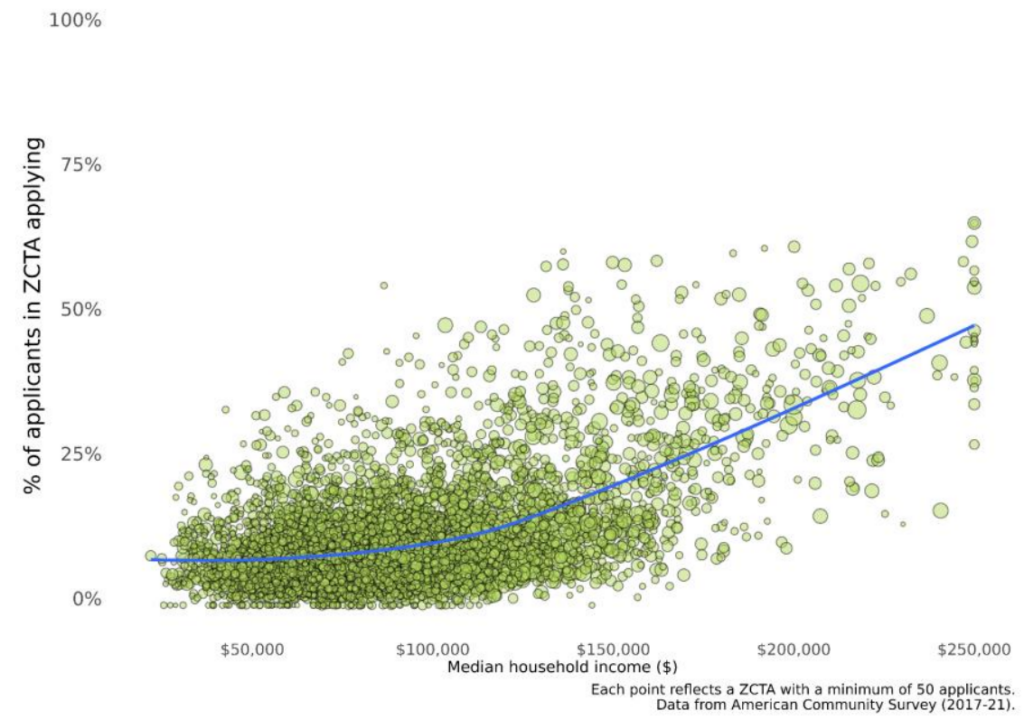Among the many changes to college admissions is the rise in the number of colleges offering Early Decision and the number of students utilizing it. As the November 1st (the early application deadline for most colleges) quickly approaches, some students are still wondering if they should apply Early Decision. Here are some considerations to help inform that choice.
Application Options
First, some background. There are two primary application times: early and regular. (Note: some schools have very different options, such as rolling decision and restrictive early action, so check with the colleges to which you’re applying and/or with an experienced college counselor — we are happy to give a recommendation to one.)
Applying Early
Early application deadlines are typically November 1st. At that time, students have two options for applying:
- Early Action: This lets students apply early so that they get their admission decisions back early (typically in December). On average, doing so gives students a modest boost to their admission chances, but the primary benefit is the optionality that it gives students. If a student doesn’t get into the colleges that they want, then they still have the regular application round to apply to more colleges.
- Early Decision: This is a binding application — if a student is accepted, then they must enroll (except if the school does not meet a student’s financial need). The boost to a student’s admission chances is substantial — on average, about a 30% increase in chance of admission. As far as admissions criteria goes, that’s a massive boost. Granted, if a student has a relatively weak application for a given school and their admission chances are thus low (let’s say 10%), then a 30% increase on a 10% chance of admission still only gives them a 13% chance of admission. That is still low. But, for a student who has a good to very good chance of admission already, Early Decision can absolutely help seal the deal and get them accepted. For instance, if a student already has an 80% chance of getting admitted, then Early Decision has a good chance of pushing them over the finish line.
Applying Regular
Regular application deadlines are typically in early to mid-January.
- Early Decision Round 2: This is another opportunity at a binding application. As such, it boosts a student’s admission chances.
- Regular Decision: No bells or whistles. You apply and find out in late-March/early-April if you were admitted.
Why the increased chance of admission from Early Decision?
Colleges are businesses. What is the mandate of a college admissions department? At most schools (all except the most elite that have such massive endowments that money is of little concern), college admissions is about keeping the lights on. That’s the first priority. Second is admitting students who will maintain or increase the prestige of the school.
So why do colleges care so much about Early Decision?
Shaping the class
It is their greatest tool for shaping their class. With Early Action and Regular Decision, colleges will give out acceptance letters, but they can’t control who will accept them back. So, they could give acceptance letters to tons of full-pay students, but, if none of those full-pay students accept them back and enroll, then the college is going to be in financial trouble. Early Decision gives colleges significant control over setting a foundation for their class: they can essentially ensure that they have enough full-pay students, commit their recruited athletes, etc.
Enrolling enthusiastic students
Early Decision also allows students to signal to a college that the college is a student’s top choice. Why would a college care? Because colleges want students who want to attend. The more students wants to attend, the more likely they are to stay at the college and not transfer, to enjoy their college experience (which helps others enjoy their experience), to get involved in the college community, and to donate after graduation and stay involved.
Influencing (manipulating?) their yield rate
With Early Decision, colleges can heavily influence their yield rate, which is the percentage of admitted students who then enroll. So, for instance, if a college admits 100 students and only 20 enroll, then the college has a 20% yield rate. This signals to the world that, for 80% of applicants, that college was only a back-up choice — in short, that particular college is not very desirable to applicants. In contrast, highly selective schools tend to have much higher yield rates. If 80% of admitted students enroll, then it’s a clear signal to the world that the college is highly desirable — it was a majority of applicants’ first choice given that when they were accepted they then enrolled.
Early Decision guarantees colleges more control over their yield rate: every student admitted Early Decision has to (besides in rare exceptions) then enroll. So 100 students admitted Early Decision will give a 100% yield rate. The boost to a college’s yield rate from Early Decision makes the college look (somewhat artificially) like it is more highly desired.
Pros and cons to applying Early Decision:
Almost all students should apply Early Action to at least one school. Granted, some students might not yet have their desired SAT or ACT score by November 1st, so they will likely continue to take the SAT or ACT and then apply to Early Decision round 2 or Regular Decision to additional colleges. However, those students should still apply Early Action to at least some colleges, even if they are applying test-optional to those schools and not submitting test scores. Why? Because what happens if something happens on the December ACT and a student doesn’t hit their score goal? Then the student will have the same SAT/ACT score but will have lost the advantage of applying Early Action. So applying Early Action to at least one school is almost a must for every student.
But what about applying Early Decision?
Pros to applying Early Decision:
- You get a very significant boost to your admission chances (especially if a school would already consider you a good fit).
Cons to applying Early Decision:
- You lose some optionality in where to attend. If a student’s top choice school is the University of Chicago but getting accepted there is a significant reach, then would a student want to “waste” their Early Decision on UChicago? Or is the student better off applying to a phenomenal school that is a target school for them, such as Boston College? Students need to be very strategic in their choice, which requires having a good understanding of their admission chances at a given school.
- You lose the ability to financially negotiate with colleges. Unless you can demonstrate that a college’s financial aid package is insufficient, then you have to attend (there are rare exceptions, but you shouldn’t assume in advance that you can be an exception). For a student on financial aid, this can be a terrible bargain. If, instead, the student had only applied Early Action to schools, then they could potentially get admitted to multiple schools, compare the offers, and even negotiate with their top choice school for a better financial aid offer.
Should a student apply Early Decision?
If getting into college (not affording it) is the primary objective, then the answer is “probably.” Granted, a student will still have to make the decision very strategically (not wasting the option on a school that is a large reach but not locking themselves into a school below their achievement level).
If affording college (not just getting into a certain college) is the primary objective, then the answer is “probably not.”
Is that fair? Personally, I don’t think so. But, again, college is a business. And, as long as Early Decision is available to people, then I don’t blame anyone for utilizing the best option available to them.
The data demonstrate that as parental income increases, applying Early Decision increases. This increase is a function of both increased fit for Early Decision and access to better information about if or when to use it.

Where a student attends college is far from destiny. A student’s chosen field of study, for instance, can have a greater impact on their future earnings than the college that they attended.
But, college is a massive investment, the prestige of the college that students attend is likely to impact their futures, and college itself is a very formative period, so it is wise to make the most informed choice.
It is, as always, our pleasure to serve families. If you would like any assistance, feel free to reach out anytime.







